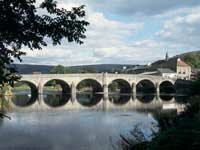| Route of the month - Builth Wells Town Walk |
 Start your walk at the Groe riverside park that one hundred years ago was used as rough grazing. See the six arched bridge built in 1775 and widened in 1925, the river marking the boundary between the old counties of Breconshire and Radnorshire. Follow the riverbank through the avenue of trees known as Abram’s Folly! Mr Abram Davies planted these trees and was called foolish in his time for so doing. Start your walk at the Groe riverside park that one hundred years ago was used as rough grazing. See the six arched bridge built in 1775 and widened in 1925, the river marking the boundary between the old counties of Breconshire and Radnorshire. Follow the riverbank through the avenue of trees known as Abram’s Folly! Mr Abram Davies planted these trees and was called foolish in his time for so doing.
Turn left at the confluence of the Rivers Wye and Irfon and follow the river Irfon to the suspension bridge.
Then a choice of route …..
For those preferring a flat and easy route (suitable for the disabled) Over the bridge and turn left. Continue until the end of the road, turn left over Irfon Bridge and follow the road back into the centre of town.
For the more energetic, go straight on by the river Irfon. At end of path cross the main road and proceed up Irfon Bridge Road. Hear the sound of the water rushing over the rocks at the bend in the river. At the top of the road looking right is Nant-y-arian, which means money brook, where during the tomes of the plague the townspeople threw their money to the farmers selling their produce.
Turn left along Hospital Road. As you descend the hill admire the fine view across the rooftops of the town across the Wye Valley to the local quarry.
Turn right into Garth Road. You can see St Mary’s Church which has a Norman Tower and the explanation for its curious position South of the chancel is that the nave of 1793 was left standing while its Victorian successor was constructed. See the two roof lines on the east side of the tower above the filled in arch. Then go along West Street and Market Street past the old Market Square known as Bank Square. It is the oldest part of town where there used to be 28 houses. Each Monday the tradesmen let their gardens and sheep were sold in the square.
Follow the route around the castle mound (noting that there is a public access point to the castle). The earthworks of this medieval motte and bailey castle are in a wonderful state of preservation. It is thought that the site could date back to Roman times having such an important position overlooking a ford across the River Wye. In 1277 a charter was granted to the town with its growing population – most people working at building the castle or associated trades.
Turn left back towards the town centre. The Market Hall, built in 1877, and now the Wyeside Arts Centre, is of stone with terracotta portrait roundels which include Shakespeare, Beethoven and an unknown. It also boasts the Builth coat of arms. On the wall of the Lion Hotel a glass case holds a plaque marking the adoption of H.M.S. Cordelia during the Second World War. We hope you have enjoyed your walk.
|
|
| Submitted By: |
Builth & District Heritage Society |
|
|
|



 Start your walk at the Groe riverside park that one hundred years ago was used as rough grazing. See the six arched bridge built in 1775 and widened in 1925, the river marking the boundary between the old counties of Breconshire and Radnorshire. Follow the riverbank through the avenue of trees known as Abram’s Folly! Mr Abram Davies planted these trees and was called foolish in his time for so doing.
Start your walk at the Groe riverside park that one hundred years ago was used as rough grazing. See the six arched bridge built in 1775 and widened in 1925, the river marking the boundary between the old counties of Breconshire and Radnorshire. Follow the riverbank through the avenue of trees known as Abram’s Folly! Mr Abram Davies planted these trees and was called foolish in his time for so doing.